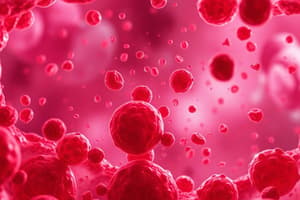Podcast
Questions and Answers
What is the function of Lipoxins?
What is the function of Lipoxins?
- To inhibit neutrophil chemotaxis and adhesion to endothelium (correct)
- To produce prostaglandins
- To cause vasodilation and increase vascular permeability
- To stimulate chemotaxis
What is the effect of NSAIDs on Prostaglandins?
What is the effect of NSAIDs on Prostaglandins?
- Enhance the activity of Cyclooxygenase
- Inhibit the production of Prostaglandins (correct)
- Have no effect on Prostaglandins
- Stimulate the production of Prostaglandins
What is the effect of Cox2 inhibitors on Cardiovascular events?
What is the effect of Cox2 inhibitors on Cardiovascular events?
- Have no effect on Cardiovascular events
- Enhance Platelet aggregation
- Decrease the risk of Cardiovascular events
- Increase the risk of Cardiovascular events (correct)
Which of the following is NOT a function of Leukotrienes?
Which of the following is NOT a function of Leukotrienes?
What is the function of Glucocorticoids in relation to Arachidonic acid metabolism?
What is the function of Glucocorticoids in relation to Arachidonic acid metabolism?
What is the source of Prostacyclin?
What is the source of Prostacyclin?
What is the primary function of histamine in the body?
What is the primary function of histamine in the body?
Which of the following is NOT a characteristic of vasoactive amines?
Which of the following is NOT a characteristic of vasoactive amines?
What is the primary function of serotonin?
What is the primary function of serotonin?
Which enzyme is responsible for the production of prostaglandins and thromboxanes?
Which enzyme is responsible for the production of prostaglandins and thromboxanes?
What is the primary function of prostacyclin?
What is the primary function of prostacyclin?
Which cells are responsible for the production of thromboxane?
Which cells are responsible for the production of thromboxane?
What is the role of arachidonic acid metabolites in the body?
What is the role of arachidonic acid metabolites in the body?
What is the primary function of prostaglandins?
What is the primary function of prostaglandins?
Flashcards are hidden until you start studying
Study Notes
Chemical Mediators
- Chemical mediators can be classified into two categories: cell-derived and plasma-derived.
Cell-Derived Chemical Mediators
- Preferentially preformed in secretory granules (vasoactive amines).
- Newly synthesized (arachidonic acid metabolites).
Vasoactive Amines
- Histamine:
- Produced by mast cells.
- Induces vasodilation and increases vascular permeability.
- Inactivated by histaminases.
- Serotonin:
- Produced by platelets.
- Induces vasoconstriction.
- Released during platelet aggregation.
- Acts as a neurotransmitter and regulates intestinal motility.
Arachidonic Acid Metabolites
- Produced by leukocytes, mast cells, and macrophages.
- Act locally and then decay spontaneously or are enzymatically destroyed.
- Released from cell membrane phospholipids by the action of phospholipases that have been activated by stimuli or inflammatory mediators.
Enzymatic Pathway of Arachidonic Acid Metabolites
- Cyclooxygenase pathway:
- Stimulates the synthesis of prostaglandins and thromboxanes.
- Lipoxygenase pathway:
- Responsible for the production of leukotrienes and lipoxins.
Prostaglandins
- Produced from mast cells (majorly) and endothelial cells.
- Prostacyclin:
- Produced from endothelial cells.
- Mediated by COX2.
- Causes vasodilation and inhibits platelet aggregation.
- Prostaglandins contribute to the pain and fever that accompany inflammation.
Thromboxanes
- Produced from platelets (majorly).
- Mediated by COX1.
- Causes vasoconstriction and platelet aggregation.
Leukotrienes
- Produced by neutrophils, macrophages, and mast cells.
- Cause vasodilation, increase vascular permeability, and stimulate chemotaxis.
Lipoxins
- Anti-inflammatory mediator.
- Produced by leukocytes.
- Inhibit neutrophil chemotaxis and adhesion to endothelium.
- Serve as endogenous antagonists to leukotrienes.
Inhibitors of Chemical Mediators
- Nonsteroidal anti-inflammatory drugs (NSAIDs) inhibit cyclooxygenase activity, blocking all prostaglandin synthesis.
- Glucocorticoids (steroidal inhibitors) inhibit the activity of phospholipase, preventing arachidonic acid metabolite formation.
Studying That Suits You
Use AI to generate personalized quizzes and flashcards to suit your learning preferences.



